#Cluster sampling design
Explore tagged Tumblr posts
Text
Cluster Sampling: Types, Advantages, Limitations, and Examples
Explore the various types, advantages, limitations, and real-world examples of cluster sampling in our informative blog. Learn how this sampling method can help researchers gather data efficiently and effectively for insightful analysis.
#Cluster sampling#Sampling techniques#Cluster sampling definition#Cluster sampling steps#Types of cluster sampling#Advantages of cluster sampling#Limitations of cluster sampling#Cluster sampling comparison#Cluster sampling examples#Cluster sampling applications#Cluster sampling process#Cluster sampling methodology#Cluster sampling in research#Cluster sampling in surveys#Cluster sampling in statistics#Cluster sampling design#Cluster sampling procedure#Cluster sampling considerations#Cluster sampling analysis#Cluster sampling benefits#Cluster sampling challenges#Cluster sampling vs other methods#Cluster sampling vs stratified sampling#Cluster sampling vs random sampling#Cluster sampling vs systematic sampling#Cluster sampling vs convenience sampling#Cluster sampling vs multistage sampling#Cluster sampling vs quota sampling#Cluster sampling vs snowball sampling#Cluster sampling steps explained
0 notes
Text


well...the salamander woods knit cardigan sample arrived with me! and, as it turns out, i made a bit of a mistake when i was setting up the digital mock ups for the shop and made the sleeves the same color as the body -while i set up the actual sample with brown sleeves.
and...of course i love how the brown sleeves look 😭😭😭
what do you guys think of brown sleeves instead of green? i kind of love how subtle is makes the acorn clusters look. let me know!! and not to worry if you preordered this design - ill be sending out a proper email as well and (if i go with this colorway) anyone who doesn't like this version will get a full refund!
p.s. ill be showing off the chest and back embroidery soon :) the green thread colors just need to be tweaked to better stand out against the body!
262 notes
·
View notes
Text
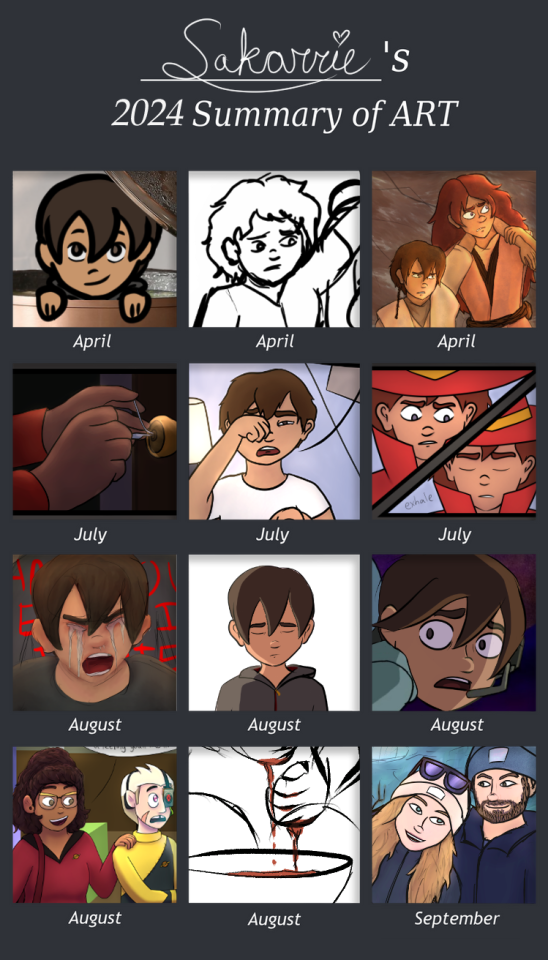
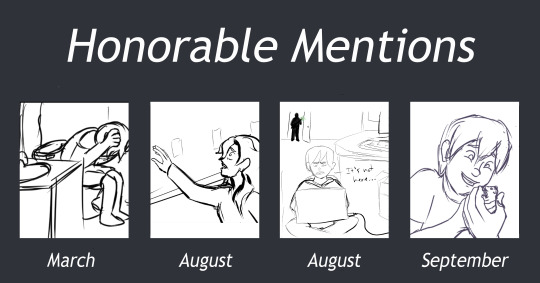
Here’s my 2024 Art Summary, terribly late as usual! We’re back to including some black and white in this year and my months were very clustered, but all things considered I was actually surprised I ended up with as many decent samples for the collage as I did. I was kinda expecting them all to be messy sketches this year lol.
Just like with my writing summary, this year the questions are a bit abridged since I didn’t do a ton of art. That said, I’m still a rambler haha, so the reflection questions are answered up the cut. The template I used is available here in case anyone else wants to use it!
What events did you participate in (with art)?Player Appreciation Week (old art), Fandom Trumps Hate (offered), CS Case Files Zine (comic!). Not really the type of art this summary is for, but I also created my first cosplay for RCCC!
What was your biggest challenge this year? Definitely motivation. Last year was a creative slump with a lot going on mentally making stuff hard. Mostly in start up energy, since once I got going, things seemed to go alright.
Did you try anything new this year? I got into a comic zine, which was new and exciting! My original plan was far too long for the creation period, though, so I spent a ton of time trying to widdle it down to 3 pages. I also did super messy spot art sketches for a friend’s fic, which ended up being a lot of fun! I also took some screenshots and then drew other characters into the show, somewhat trying to match the show’s style, which was definitely interesting.
Where do you think you most improved? I’m going to go with rendering again! I really love playing with color and lighting, and several of my collage pieces this year were just adding rendering to old pieces. I have a lot more confidence with it now, though I still sometimes feel like my pieces don’t end up as dynamic as I’d like. I also did a lot better at following inspiration and not being as perfectionistic this year.
What are you most proud of? I’m really proud of getting into a comic zine, even though it likely wasn’t that competitive. The fact that I got in for comics despite never having done art for a zine before is crazy to me! I was a pinch hitter, so I wasn’t originally selected, but I’m still honored I got picked eventually. I also am really proud of the August fully rendered piece of Player screaming. I did that one in almost one sitting, probably around 4ish hours, and it was one of my first times doing full color/rendering without cleaning the sketch much at all. Overall, I was very excited at how well it turned out and I feel like the messy emotions really come across!
How’d this year compare to your 2023 goals?Shoutout to past Sakarrie for giving me a straight bullet point list. MUCH easier to work with lol.
2024 Goals Met: -Number One Priority: Create for me and don’t put myself in a place to get crazy burnt out and still have requirements. If I meet this goal, then it’s okay if I don’t meet any of the others. (It would be sad.... But I would still count it as meeting overall goals.) -Participate in Summergen and PAW Week (Art or Fic) -Have a fully usable Zine Portfolio (Currently need more merch samples and rendered pieces with backgrounds) -Apply to new TOH Zines or other loved fandom zines. If I end up getting into any, I can pull back, but since that doesn’t seem likely, I want to get into the habit of always being ready to apply with what I have. -Play with different brushes and rendering styles -Not exactly art, but I want to have a finalized long-term merch display plan for all my items -Do ONE of the following: 1. 30 minutes digitized so it can be shared with music 2. Open Up Your Eyes fully thumbnail 3. Fanworks for other people’s fics 4. Participate in an extra bang or exchange with art 5. Design and manufacture a pin
The ones that don’t have strikethrough are a bit of a stretch, but I’m gonna give them to myself. While I haven’t added more pieces with backgrounds and need to reorganize my zine portfolio, it is in a decent place where I feel like I can use it and it will accurately represent my best work. I also didn’t really purposefully experiment with rendering or brushes, but it did happen naturally a little, so giving that to myself too. As for the ONE of the following list, I actually did digitize my 30 minutes thumbnails! It’s just not to music, so doesn’t count. Also holy dang, last year Sakarrie was ambitious with the proposal of manufacturing a pin haha.
2024 Goals NOT Met:-Design Handplates charm as anniversary gift (November) -Design CS Charm-Make an ongoing project list to pin to my tumblr. This applies mostly for fics, but that way people coming to my page can see what fandoms I’m actively creating for and what they can look forward to (as well as have an opening to ask questions if they’re interested). -Post more (at least 10 times throughout the year) and add my best pieces to instagram (8+ pieces by end of year). -Draw something from scratch every month, no matter how small
Yeah, these all I absolutely failed with. Oops. Probably gonna be using a fair few of these as my new goals haha.
Alrighty then, now it’s time for 2024 goals!! I think I want my main focus to be to try to draw more frequently. I’ve found that so much of what prevents me from drawing is startup energy, and once I actually get going, it all comes much easier.
Specific goals: -Organize a go-to zine portfolio for comics, merch, page art, and spot art applications -Try to draw every month (even the tiniest phone doodle counts) -Design Handplates charm as anniversary gift (November?) -Design CS Charm-Make an ongoing project list to pin to my tumblr. This applies mostly for fics, but that way people coming to my page can see what fandoms I’m actively creating for and what they can look forward to (as well as have an opening to ask questions if they’re interested). -Post more (at least 5 times throughout the year) and maybe look into Cara or whatever the non-instagram art app is. -Experiment more with drawing in sketchy art style with full color/rendering -Experiment more with screenshot redraw/character replacements -Do ONE of the following: 1. 30 minutes put to music 2. Open Up Your Eyes fully thumbnail 3. Fanworks for other people’s fics 4. Participate in an event with art 5. Draw and post for a new/niche fandom (Infinity Train, Sym-Biotic Titan, Irondad, The Flash, etc)
Overall, how’d the year go? Better than I expected when I first started pulling up my art haha. I didn’t push myself on anything but the CS comic, and that was pretty early on in the year. I also did a fair few doodle/sketch projects and followed the muse when it wanted to do rendering without drawing.
#sakarrie's art#carmen sandiego#the owl house#non fandom#cs player#cs carmen#cs ivy#toh hunter#camila noceda#tw blood#gen#angst#fluff#hurt/comfort#art summary#2024 summary of art#end of year reflection
17 notes
·
View notes
Text
POLL RESULTS JUST DROPPED!!
My hockeyblr experiences are largely catered to my own personal tastes -- mostly Leafs, a little Penguins and Stars, one or two who post about Stevie Y and Sergei Fedorov. These are obviously not the only teams out there.
This study was designed to survey as much of hockeyblr as it possibly could, gathering data on which teams people like and to what degrees. There were five questions and a free space -- my attempt to ask people to rank the teams they enjoyed in three levels, from religiously followed to casually affectionate, and an additional couple of questions on love for players versus team. I received over 500 responses. Here are the results.
Yeah, yeah, you all want to know: The most popular team is the Penguins, by a long shot, then the Leafs.
Because my sample size (n = 523) is actually fairly small compared to the number of NHL teams there are, I find definitive rankings tend to be difficult. It’s also worth noting that, as a mainly Leafs blog, my numbers are definitely going to be skewed a little in favour of the Leafs.
Your Guys
These are the teams closest to your heart: the ship you go down with, metaphorically or, depending on how married your old men are, literally. For me, I picked just the Leafs.
The average respondent had 1.9 teams in this category. The most popular, by far, was the Pittsburgh Penguins. Below is a table of teams, arranged roughly into tiers by the number of respondents. Each team has the number of respondents in brackets next to their three-letter code.
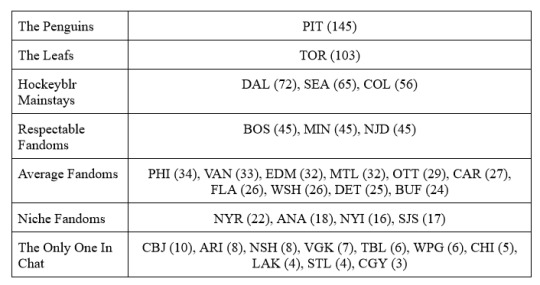
I allowed people to pick as many teams as they would like; the average person picked 1.9 teams, but here’s a distribution of how many teams they picked:
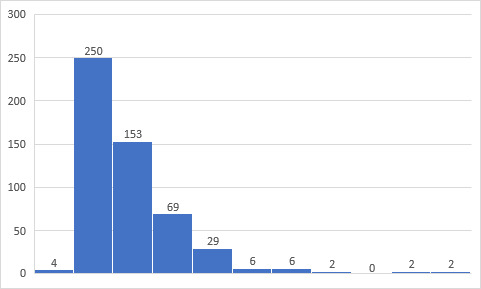
4 people picked 0 “your guys” teams, and 2 people picked seven, nine, or ten each teams. Just about half of people had one main team.
I then wondered: what teams were people most likely to only follow? That is, if you hold [x] team in the closest part of your heart, are you more or less likely to also hold any other teams? Almost exactly 25% of picks were solo; I wondered if there was any correlation at all.

Only a little bit! Of the samples large enough to actually consider (so: nothing in that cluster at the bottom left, who all received fewer than 10 picks total, and a few of whom -- CGY, CHI, NSH -- received zero solo pickers), the most devoted fans chose the Sharks, the Bruins, and the Leafs. The fans who liked the most other teams chose the Avs, the Kraken, the Canucks, Panthers, Sens, and Ducks.
Probably a next step would be to look for correlations: if people are a fan of one team, are they more likely to be fans of another? THAT BEING SAID that’s a lot of regressions. Maybe keep an eye on that for the future, but I don’t know!!
Objects of Enjoyment, and Generally Nice
These two were successive tiers meant to distinguish teams that people like from the ones in the category above. I admit I probably could have phrased the questions better; I received several comments saying that they’d watch any hockey when they wanted to put a game on. The dynamics between Your Guys versus Objects of Enjoyment versus Generally Nice would best be described as devoted fan of versus casual fan of versus favourable opinion towards.
As I said a few paragraphs back, people picked 1.9 “devoted fan” teams on average. Again on average, they picked 4.7 “casual fan” teams and 6.5 “favourable opinion” teams. Not all ratios are equal, though! Some teams had significantly more casual than devoted fans, and others still were much more liked generally than average.
I gave each team’s “devoted” count an index number of 1 and measured their casual and favourable count as a ratio against the index number. The teams assembled themselves into a few groups.
No Commitment

Arizona and Anaheim have decided to be soulbonded (Excel refuses to let them have different-coloured dots) and it took me three hundred million years to attempt to (and unsuccessfully) fix, so let’s ignore that. These teams all have a fairly high slope of interest -- a range of casual interest at about five times the pace of fervent interest, and good opinion at about ten times fervent interest. The Calgary Flames are an outlier on the entire graph, not just here.
Casual Interest
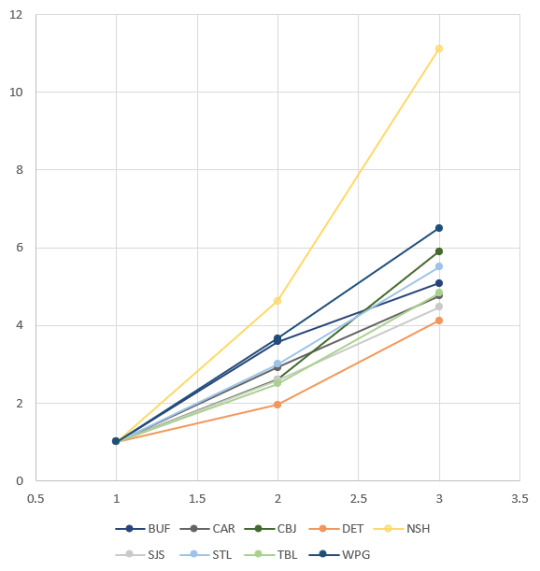
I gave up on trying to colour teams according to their real colours shortly after the Anaheim/Arizona debacle. Please employ the legend. Nashville is included on all five graphs for reference. These teams all have a casual interest factor of about 3, and a favourable opinion factor of around 5; the same ratio as the casual fans of the teams in the first category to their fervent fans.
Saturated Market
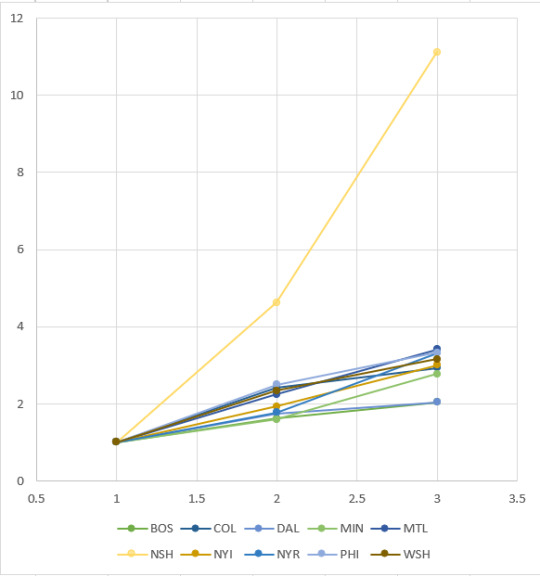
These teams have a much lower ratio of hardcore:casual:favourable fans, at about 1:2:3.
We Get It, Those Are Your Guys

Pittsburgh and Toronto; these teams have an almost equal ratio of all three categories.
...Whatever This Is
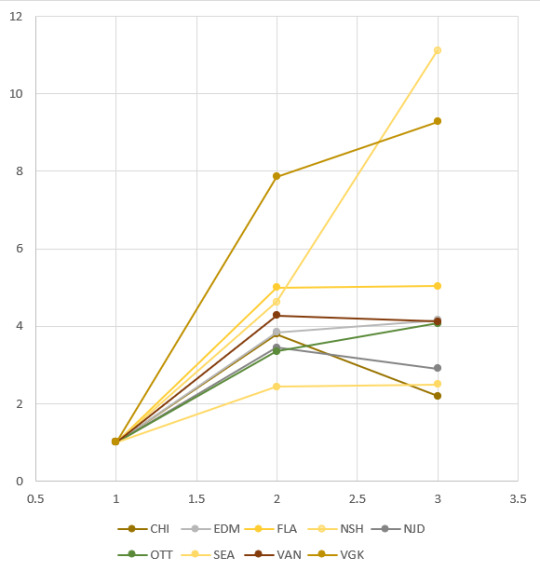
Every other category is defined by its ratios; this category is defined by its shape. While all teams have their rate of hardcore fandom set as 1, the other two tend to increase in a roughly linear form, without too much significant difference between the first interval and the second interval.
These teams, though (again, Nashville is for scale) don’t do that: they have a set increase between hardcore and casual, and a significantly smaller increase (or, in a couple cases, a decrease) between casual and favourable. This suggests perhaps some kind of divisiveness; if you’re not already in there, do you really want to get in further? Either that, or it’s something closer to what the Leafs and Penguins have: that is, a devotion. Like you’re in or you’re out.
Taking these values together
Because the casual:hardcore ratios are measured as indexes and not absolute values, they say nothing about the actual popularity of the team in question -- Calgary is one of the least popular, which is why I assume it’s so weirdly high up; small sample sizes lead to higher error values!
But we do have the absolute values, so we can measure them against each other.
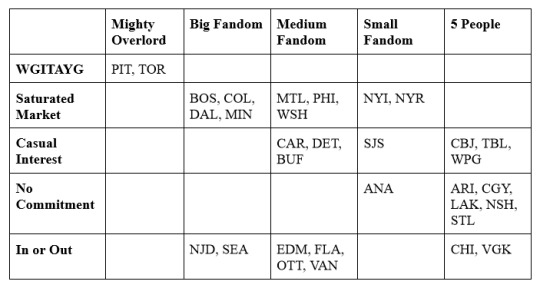
If we consider the “In or Out” to be a category of its own while the other four are along more of a continuum, then we can absolutely see a correlation here -- larger fandoms tend to have more involved fanbases.
Players or Teams?
I also asked participants if their guys tended to be players or teams -- and if those they liked at a more casual level tended to be players or teams.
The results are… not particularly surprising.

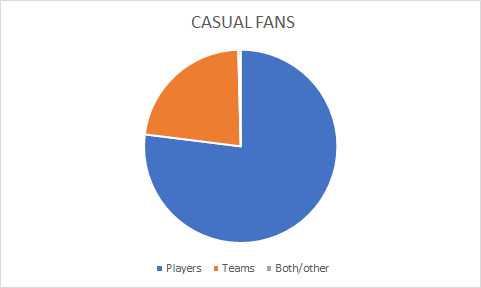
On a hardcore level, people tended to prefer teams, although the variability was pretty slight. On a casual level, individual players were much more popular.
I also wondered if people who chose more teams in the hardcore fan question tended to do that because they prefer players.
On average, people who picked players on their hardcore level chose 2.1 teams. People who picked teams chose 1.7 teams. That’s definitely a difference!
Fun Shtuff
I got way more write-in responses on the hardcore player/team question than on the casual question, including this:

Three separate people answered “Minnesota Wild” for their guys and chose no other teams on any level. Hell yes. (One person also did this for the Kings.)
It took about 300 responses before the first Flames fan (at the hardcore level.)
On all three levels, the Seattle Kraken are really popular -- they’re in the top five in each.
What's Next?
If I were to update this survey, I would probably include a question about where all of you are from -- some people (like me) follow their hometown team, while some people most certainly don't (shoutout to the one person from Edmonton who dislikes the Oilers) and others still don't have a hometown team (shoutout to my brasilian + european + etc mutuals and everyone else!!)
Feel free to shoot me an ask if you want me to do anything else with this data -- examine a specific team, give actual casual fan/etc counts and total aggregate rankings, anything else!
205 notes
·
View notes
Text

New SpaceTime out Monday
SpaceTime 20250414 Series 28 Episode 45
Why does the lunar have less water than the Earth facing side
Lunar rocks collected by China’s Chang'e-6 sample return mission suggest the Moon’s far side is far drier that its Earth facing side.



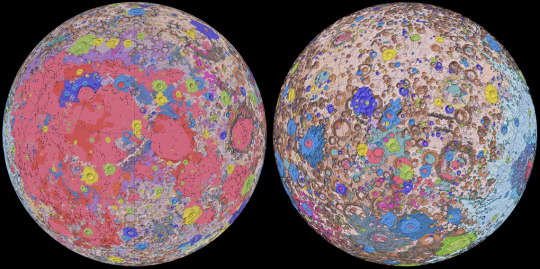
The asteroid targeting the Moon
Asteroid 2024 YF4 which came to fame after it was designated a possible Earth impactor now appears to be targeting the Moon.

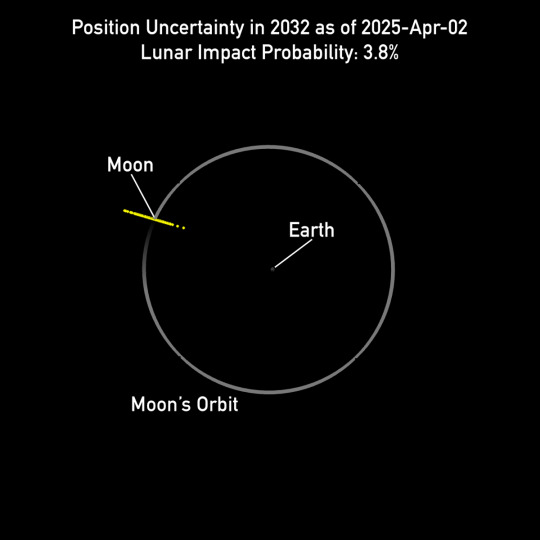
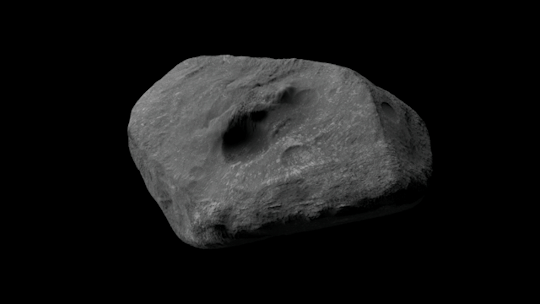

How singing stars expose their galactic past
Astronomers studying the Messier 67 open star cluster have used stellar seismology to determine how stars in the cluster have evolved over cosmic time.
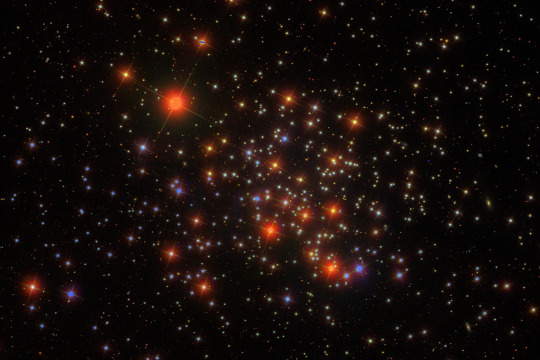


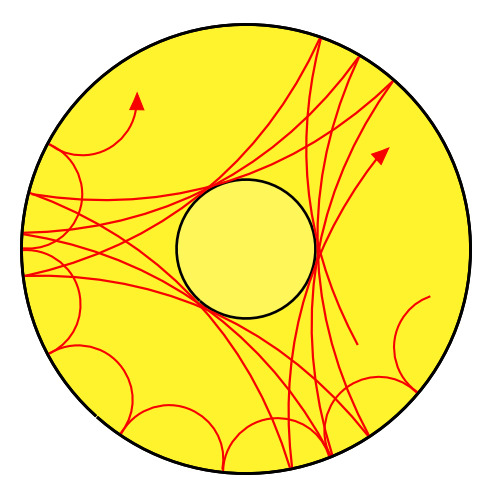
The Science Report
The diabetes drug linked to a lower risk of Alzheimer's and dementia.
Questions over claims the extinct dire wolf has been resurrected.
How ancient famers brought fishing to the Pyrenean mountains
Skeptics guide to the flood of misinformation in Nutrition advice
SpaceTime covers the latest news in astronomy & space sciences.
The show is available every Monday, Wednesday and Friday through your favourite podcast download provider or from www.spacetimewithstuartgary.com
SpaceTime is also broadcast through the National Science Foundation on Science Zone Radio and on both i-heart Radio and Tune-In Radio.
SpaceTime daily news blog: http://spacetimewithstuartgary.tumblr.com/
SpaceTime facebook: www.facebook.com/spacetimewithstuartgary
SpaceTime Instagram @spacetimewithstuartgary
SpaceTime twitter feed @stuartgary
SpaceTime YouTube: @SpaceTimewithStuartGary
SpaceTime -- A brief history
SpaceTime is Australia’s most popular and respected astronomy and space science news program – averaging over two million downloads every year. We’re also number five in the United States. The show reports on the latest stories and discoveries making news in astronomy, space flight, and science. SpaceTime features weekly interviews with leading Australian scientists about their research. The show began life in 1995 as ‘StarStuff’ on the Australian Broadcasting Corporation’s (ABC) NewsRadio network. Award winning investigative reporter Stuart Gary created the program during more than fifteen years as NewsRadio’s evening anchor and Science Editor. Gary’s always loved science. He studied astronomy at university and was invited to undertake a PHD in astrophysics, but instead focused on his career in journalism and radio broadcasting. Gary’s radio career stretches back some 34 years including 26 at the ABC. He worked as an announcer and music DJ in commercial radio, before becoming a journalist and eventually joining ABC News and Current Affairs. He was part of the team that set up ABC NewsRadio and became one of its first on air presenters. When asked to put his science background to use, Gary developed StarStuff which he wrote, produced and hosted, consistently achieving 9 per cent of the national Australian radio audience based on the ABC’s Nielsen ratings survey figures for the five major Australian metro markets: Sydney, Melbourne, Brisbane, Adelaide, and Perth. That compares to the ABC’s overall radio listenership of just 5.6 per cent. The StarStuff podcast was published on line by ABC Science -- achieving over 1.3 million downloads annually. However, after some 20 years, the show finally wrapped up in December 2015 following ABC funding cuts, and a redirection of available finances to increase sports and horse racing coverage. Rather than continue with the ABC, Gary resigned so that he could keep the show going independently. StarStuff was rebranded as “SpaceTime”, with the first episode being broadcast in February 2016. Over the years, SpaceTime has grown, more than doubling its former ABC audience numbers and expanding to include new segments such as the Science Report -- which provides a wrap of general science news, weekly skeptical science features, special reports looking at the latest computer and technology news, and Skywatch – which provides a monthly guide to the night skies. The show is published three times weekly (every Monday, Wednesday and Friday) and available from the United States National Science Foundation on Science Zone Radio, and through both i-heart Radio and Tune-In Radio.
#science#space#astronomy#physics#news#nasa#astrophysics#esa#spacetimewithstuartgary#starstuff#spacetime#hubble telescope#hubble space telescope#hubble
8 notes
·
View notes
Text
quick post on NPD (narcissistic personality disorder) :
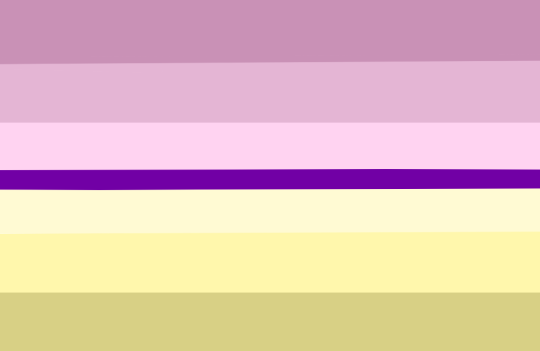
"Narcissistic personality disorder (NPD) is a complex personality disorder often detected with other affective and personality disorders. [...] NPD is under the umbrella of Cluster B personality disorders, which include antisocial personality disorder, histrionic personality disorder, and borderline personality disorder."
- National library of medicine (ncbi.nlm.nih.gov) [https://www.ncbi.nlm.nih.gov/books/NBK556001/]
♚-♔-♚-♔-♚-♔-♚-♔-♚-♔-♚-♔-♚-♔-♚-♔
"Genetic and non-genetic influences on the hierarchy of traits that delineate personality disorder as measured by the Dimensional Assessment of Personality Problems (DAPP-DQ) scale were examined using data from a sample of 483 volunteer twin pairs (236 monozygotic pairs and 247 dizygotic pairs). [...] Additive genetic effects and unique environmental effects emerged as the primary influences on these scales, with unique environmental influences accounting for the largest proportion of the variance for most traits at all levels of the hierarchy."
- Jang KL, Livesley WJ, Vernon PA, Jackson DN. Heritability of personality disorder traits: a twin study. Acta Psychiatr Scand. 1996 Dec;94(6):438-44. doi: 10.1111/j.1600-0447.1996.tb09887.x. PMID: 9020996. [https://pubmed.ncbi.nlm.nih.gov/9020996/]
♚-♔-♚-♔-♚-♔-♚-♔-♚-♔-♚-♔-♚-♔-♚-♔
i hate how people online tend to water down the initial definitions and jump into conclusions. no one said "it's caused by childhood trauma." stop putting things into a box when they're way more complex and diverse and nuanced.
npd is primarily caused by trauma but very often individuals have a genetic predisposition to npd.
♚-♔-♚-♔-♚-♔-♚-♔-♚-♔-♚-♔-♚-♔-♚-♔
flags
since there are two flags for npd that ive seen floating around, and since I've had people asking me why i chose the first one for this npd blog over the other, and some have never seen the first one before, im gonna give a quick explanation for both :

the first flag is the npd flag. it represents the disorder itself.
created by @/beyond-mogai-pride-flags on august 1, 2017 : https://www.tumblr.com/beyond-mogai-pride-flags/163661799375/narcissistic-personality-disorder-flag
"Design choice: the artist chose pastel pinks and yellows as they are very eye-catching colors that feel like very "outgoing" colors. In line with the outgoing and self assured face that people with NPD project, the pink is associated with confidence and the yellow with insecurity and anxiety. The purple is for royal purple, in the center, to represent the focus on self."
♚-♔-♚-♔-♚-♔-♚-♔-♚-♔-♚-♔-♚-♔-♚-♔


the second flag is the npd awareness flag. it's a flag representing everyone fighting for npd awareness, that including non-npd allies.
created by @/npdsafe then rebloged with the stripe meanings by @/liom-archive : https://www.tumblr.com/liom-archive/725390566188285952/npdsafe-npd-awareness-flag-i-wanted-to-make-a
concerning the second flag, there is also an alternate npd awareness flag :

created by @/npd flag : https://www.tumblr.com/npdflag/694773969935630336/an-alternate-version-of-the-npd-awareness-flag-by
♚-♔-♚-♔-♚-♔-♚-♔-♚-♔-♚-♔-♚-♔-♚-♔
the reason i chose the first flag is, well, mostly because it's the first that appeared in the research bar lol, but also because i wanted to highlight and focus on the disorder itself instead of using the more generalised flag. to me it felt a bit like using the LGBTQ ally flag instead of the flag of a specific sexuality. on top of that, the majority if not all npd related accounts are using the second flag, so i wanted to make something a bit more unique with my blog presentation. and finally, i just like aesthetically the first one more hehe.
both flags are awesome and you are free to prefer one over the other, aesthetically or for any other reason. i simply chose to use one over the other for simplicity.
12 notes
·
View notes
Note
Can I ask for 17. noticing their individual quirks from the blossoming romance prompt list with Simpatico? <3
WHAT A COINCIDENCE THAT I STARTED REWRITING LIKE 3 HOURS BEFORE I SAY THE POST ABOUT YOUR BIRTHDAY!! Anyways, Happy Belated Birthday!!! Enjoy some simpatico nonsense:)
Ao3 Link Here
Perceptor narrowed his optics down at the pile of clutter before him. Clutter was a kind, professional, polite way of describing explosive havoc of disorder and chaos that made up the dimensions of Brainstorm’s desk. Disgusting was another word that came to mind.
::How do you live like this?::
::Oh please, let’s not exaggerate. It’s not that bad.:: came Brainstorm’s groan.
It was not an exaggeration. If anything, it was an understatement.
Perceptor’s internal processors had a difficult time distinguishing just what exactly he was looking at. The only way to actually piece through what was on the desk was to deconstruct it layer by layer. A cross-section analysis.
The bottom-most layer- the foundation, if you will -were dried dribbles of fuel intermingled with a noxious dusting of sentiment and dirt. One of Perceptor’s background scanners identified a cluster of granulated particles to be aged candied energon treat crumbs. An entire rust strick made the foundation brick, its sticky residue gluing it to the hard surface of the desk. Perceptor idly pondered if its removal would cause the entire system to fall apart. And while his internal protocols desperately would like the area cleaned, organized and sanitary, he was not willing to find out if his hypothesis was correct.
Cemented to this foundational core layer was the secondary mantle layer. This, from what Perceptor could read, was a scattering of notes all in Brainstorm’s sloppy, near illegible scribble. Tattered napkin bits from Swerve’s and printed notices from Ultra Magnus acted as the canvas for dynamic invention designs, schematics and impossible (and implausible) equations with attached nonsensical theorems. Several datapads acted as structural weights. When flicked on, Perceptor wasn’t sure if he felt amusement, exasperation or a sickly, prickling bashfulness in seeing several of his academic research papers and studies riddled with extensive notes, doodles and elaborations from Brainstorm.
It didn’t take away from the utter disaster that was Brainstorm’s work space but it did soften the blow. Still, Perceptor would prefer if his research wasn’t adding to the disgusting catastrophe that made up Brainstorm’s desk. Perhaps a bookshelf or three would greatly benefit organization.
Level three- the crust -was as troublesome as the other two layers of clutter, if not more prone to disaster by their fragile and incongruous shapes. Trinkets , Brainstorm affectionately called them. Garbage , Perceptor was more keen on describing. In truth, they probably served best as paperweights, however haphazardly placed they were.
The sentimentality was not missed on Perceptor and a part of him could even find the collection charming. Endearing.
Perceptor had bared witness to the slow accumulation over the course of the Lost Light’s journey but had never really taken the time to truly examine them. Now he did, his optics scanning over the seemingly random series of objects: little samples of rock, crystal, fossil collected on pit-stop planets, a Rodi-Star for Temporal Excellence half hanging off the desk, a cluster of thumb drive stocked with films, music, and other media either gifted or stolen from Rewind- Perceptor was still not sure. Little gadgets and doodles from Nautica were in abundance and horrible tiny contractions built by Whirl intermingled with them. There was even a small toy-like bauble on the corner of his desk from Chromedome, Perceptor had been present when the Mnemosurgeon had left it there and Brainstorm never moved it, simply fiddled with it absentmindedly while mulling over his work before throwing it back to the corner of his desk.
All these items, papers and dirt and yet Perceptor still did not actually find what he was looking for.
With a heavy sign, Perceptor responded to the insisting ping in his comms.
::How do you expect me to find anything on your desk?::
Brainstorm’s response was bitingly quick. ::What are you talking about? Everything is organized!::
::It’s garbage, Brainstorm.::
::Use that brilliant mind of yours and you’ll see everything has a purpose.::
::What purpose do Ultra Magnus’s cease orders from 28 cycles ago have?:: Perceptor didn’t dare touch the fragile, lopsided stack in fear of it tumbling down and only adding to the mess.
::They are counterbalances. Don’t move them or the desk will collapse.:: Perceptor had no doubt in the truth of that statement even if its intent was a joke.
::We are cleaning this when you return to the ship.::
::It doesn’t need any cleaning! I know where everything is!:
Perceptor let out a derisive snort. He could picture perfectly the little fluttering of Brainstorm’s ailerons, his hands moving in frustration.
::The tell me where your cathetometer is.::
It was the reason for this call in the first place. For rare occasion, Perceptor had the lab to himself with Brainstorm accompanying Rodimus’s small expedition team. It’s not Perceptor’s fault his colleague forgot his equipment but he was not about to be a complete aft in not assisting. He just wasn’t going to personally dig through Brainstorm’s garbage heap of a desk alone.
::Hmm, if you don’t see it in top it’s probably in one of the drawers.::
Perceptor rounded the desk to see six drawers lining the sides of the desk with three on each side.
::Which one?::
::The left side. I keep the important stuff there.::
Perceptor raised an optic ridge and couldn’t help but ask ::And what do you keep on the right?::
::Come on Percy, let me have a little mystery, a touch in intrigue.::
::Nevermind, I don’t want to know.::
Perceptor didn’t need to be present to know Brainstorm was pouting, blast mask intact or not. Even hundreds of meters between them and Perceptor knew a pouting, sulking Brainstorm anywhere.
::You’re no fun.::
::Yes I am.:: Perceptor replied back as he started with the top drawer, pulling it open only to find it crammed to the brim with even more data pads. All of them pressed together to a block so not even a tiny piece of dust could enter. Perceptor slammed the drawer shut. ::How do you live like this?:: he found himself reiterating.
::Oh, not fun loving Perceptor still complaining about my desk. Is that fun? Cleaning and organizing?::
::You’re a scientist. How do you find anything in this?::
::Tell me how you are fun in explicit detail and I’ll tell you my organizational strategies. We can make a date of it.::
Perceptor snorted as he opened the second drawer. This was filled with several instruments and after some careful digging, he found the cathetometer . ::We can clean your desk together.::
::You must be a hit at the club, Percy. Really. Absolute stud. What moves do you have? The pencil sharpener? The label maker? The file organizer? Actually, you can’t claim that one. Minimus invented and perfected that one. ::
Perceptor could have told Brainstorm at any moment that he had found what the other mech was looking for but, he held onto the tool for a moment, softly smiling to himself as Brainstorm rambled insults to him. It shouldn’t be charming, it shouldn’t be amusing, it shouldn’t bubble up any sort of affection. And yet.
::I’ve seen you dance, Brainstorm. I wouldn’t speak so confidentially with what you’ve demonstrated.::
::Are you saying Minimus is a better dancer than me? Because you surely can be saying that you are a better dancer. I mean, I think you’ll fall apart if you stepped foot on the dance floor.::
::It hasn’t happened yet.::
::When have you been dancing at Swerve’s? Before or after you deep clean and detail your desk every day?::
::Funny.::
Without even thinking about it, Perceptor opened the third drawer. He stopped as it slid open, its few contents rocking in the sway. Recognition lit his processor in a warm, shy heat.
::I’m hilarious. So funny and smart and amazing and talented and resourceful. Speaking of resourceful…did you find the my cathetometer yet? I put googly eyes on it. For personality. Can’t miss it.::
Perceptor felt the warmth spread across his faceplates. ::I did.::
::Oh Percy, I could kiss you. Tailgate is almost back at the ship if you can give it to him. The mods to his hoverboard make him almost as fast as Rodimus. He’s pissed. Anyways I told you it would be easy to find. All my important stuff is.::
Perceptor barely heard a word of what Brainstorm said. Only sending back a short affirmative as he stared at the drawer.
::Perceptor? You alright?::
With a sharp invent, Perceptor closed the drawer shut firmly.
::Perfectly fine. I’ll be ready to pass it off to Tailgate. I’m clearing your schedule for the next cycle. We are cleaning your desk. I can’t work knowing you are working like this.::
::Percy! It’s fine. I don’t need your shitty excuse for a date-::
::It’s not a date.:: Perceptor swiftly cut off. ::This is a work hazard that is being remedied immediately.::
Brainstorm’s response was muted, delayed. ::Okay, okay. We’ll clean it up. I’m sure you’ll have a checklist and everything.::
Perceptor let a small smile come to his face even though he could hear the telltale rumbling of Tailgate’s juiced up hoverboard. ::Of course. You shouldn’t expect anything less from me. If you manage to get it done by shift’s end, I’ll buy you a drink. Maybe if you are lucky, we can dance.::
Brainstorm’s next several responses were streams of incoherent stutters that formed a very excitable agreement. Perceptor didn’t feel the need to continue the chatter as he passed over the tool to Tailgate who only gave him a slightly confused look at his smile. Perceptor didn’t care, not when he knew what lay at the bottom of Brainstorm’s important drawer.
Sentimental fool.
20 notes
·
View notes
Text
A BRIEF HISTORY OF THE DISCOVERY OF COSMIC VOIDS!!
Blog#299
Wednesday, May 24th, 2023
Welcome back,
At first the sum total of large, orderly structure in the Universe appeared to arrive in two categories. There were the clusters of galaxies – an unoriginal but descriptive name – each a dense ball with anywhere from a few dozen to a few hundred galaxies, all bound together by their mutual gravitational embrace. And then there were the field galaxies, lonely wanderers set apart and adrift from the clusters, not bound to anyone but themselves.

That was it: the clusters of galaxies, the field galaxies, and the megaparsecs of emptiness that enveloped them all.
But technology is technology and advancement is advancement. The telescopes grew more powerful. The field of cosmology involved more people. The techniques improved. The development of image amplification systems – the distant forerunners of your smartphone camera – allowed astronomers to peer ever further into the dark.

With every new survey taken, the number of galaxies in our Universe increased. With every night of observation, our window into the cosmos widened.
By the early 1960’s, astronomers began to realize that there was more in the Universe than mere galaxies and clusters. There was something larger – the supercluster. It only took a small sample of galaxies to reveal the shape of the first known supercluster, the Local Supercluster, with the galaxies themselves – each one the mass of a trillion suns – reduced to a tiny dot of light, acting as mere tracers of the vast structure that stretched for a million parsec on a side.

The faint sketches that they could produce revealed that galaxies clump into clusters, and clusters clump into superclusters, the beginnings of our understanding of the large-scale structure of the Universe.
Time passed. Observations pushed on, finding galaxy after galaxy and cluster after cluster. Until one day, they didn’t. One mapping of the cosmos produced an unexpected result. Once again this was a survey of galaxies, clusters, and superclusters. Once again this took only a small number of galaxies to reveal the grand structure of the cosmos.

Once again astronomers were intent to find the pattern, the hidden meaning in this grand design. Once again we were going to map the heavens and make it ours. But where a fair sampling of galaxies should have revealed yet more distant dots of light, there was…nothing.
A blank space.

It was a cosmic accident. A blight in the Universe. A Sahara too vast to describe except with the reducing, almost meaningless jargon of the astronomer – an empty patch devoid of galaxies almost 20 megaparsec, or 65 million light-years, across.
In 1978, we found a silence among the stars: our first cosmic void.
Originally published on www.universetoday.com
COMING UP!!
(Saturday, May 27th, 2023)
"WHAT IS QUANTUM GRAVITY THEORIES??"
#astronomy#outer space#alternate universe#astrophysics#spacecraft#universe#white universe#space#parallel universe#astrophotography
41 notes
·
View notes
Text

Omega Centauri, an Original Skit
bc i'm on a roll with these
Also based on a dream I had. Got a lot of those...
Omega Centauri, aptly named after the biggest and brightest cluster of stars, is a secret society that hand picks the children of old blood families to be taught the occult ways of the world. Like Hogwarts if it was low-key a cult and a lot darker. About 100 students are picked from all over the world. Ages range between 19-21. This sect specializes in the root of magical branches, which might leave their teachings outdated but incredibly powerful and equally dangerous. The kind of people who argue human sacrifice had a real kick to it. . .
Students are kept on campus grounds for the entire time they're enrolled. It's large and surrounded by acres upon acres of forest on one side, but also somewhat near a coast line. No one is quite sure where they are due to the fact that upon acceptance you're whisked away via teleportation to campus grounds. You are not allowed to leave for the next four years, assuming you survive. No one is guaranteed to graduate and most of the students here were raised strictly for this, likely children of alumni. Good news is that all the supplies you'll need are provided to you.
Upon acceptance and after the welcome ceremony, the first month will be spent learning bare basics and testing where each student's magical aptitude lies. This is the only time where students are not allowed 'friendly fire'. At the end of the first month, the students will be run through a series of tests and trials. By the end of this, ideally, each student will be picked by a Patron. There are technically 5.
The Night Mother The Sphinx The Reverent One The Baneful Dread The Last Disciple
Notably, none of these titles are the entities' actual names except for The Sphinx
Being chosen will inevitably shape a student, literally and metaphorically, along the next four years as each Patron has different cores and values. Not being chosen is a possibility, but it makes survival much harder. Faculty is not responsible for keeping students alive, killing each other is not a punishable offence, and there is little that could actually land someone in trouble here. I mean, aside from maybe annihilating your entire graduating class.
If that sounds insane, it should.
The catch to this skit is that I was never meant to be picked. In a pit of jealousy, someone who hadn't been chosen accosted someone who had before they could properly open their invitation in an attempt to steal it. This resulted in the death of both parties and I accidentally find and open the invitation instead. which is kind of realistic bc I pick up shit off the ground all the time, like a gremlin
As a result, I instead take the original student's spot by being teleported and essentially magically kidnapped. I basically unintentionally steal their identity. Good news, it wasn't a particularly influential nor big family name, so no one immediately knows I'm not said student. Bad news, for that exact reason no one is entirely sure whether I'm a threat or not bc they've never heard of me.
I'm basically put in survival mode for the next four years unless I can somehow either figure out a way to escape or burn this place to the ground from the inside out. Or, alternative to all that, I ride the lightning for the next four years and see where it gets me.
This skit is meant to be a wild ride and most of the plot has been put purely in the hand of The System rather than myself. It's supposed to be giving 'Never let them know your next move'. Additionally, as you can imagine, this skit will probably often be 18+ and any posts in relation to it will be appropriately labeled when necessary.
Lastly, I design update posts for each skit. This one was too pretty not to share ahead of time. Here's the sample:

I don't know if I plan on using my actual name here or if I really do plan on using a fake one for the sake of the skit. . . I'll get back to y'all on that.
#reality shifting#shiftblr#shifters#shifting community#desired reality#shifting motivation#shifting blog#original dr rambles
1 note
·
View note
Note
The dense foliage of Isla Nublar concealed both its prehistoric wonders and its dangers. Alan Grant, a seasoned paleontologist, had been navigating this untamed island for days, collecting samples and documenting the remnants of dinosaurs that had once roamed these lands. Every rustle in the underbrush and every chirping insect spoke of the island's vitality, but they also hinted at the lurking perils.
Meanwhile, deep within the verdant labyrinth of the jungle, a tiny three-inch woman named Selene embarked on her own expedition. She wasn't a fairy; she was an adventurer of her kind, a member of a tribe who had learned to thrive in the world of giants and dinosaurs.
Selene's curiosity had led her deep into the heart of Isla Nublar. Her tiny form was clothed in attire made from leaves and vines, designed for both camouflage and practicality in this vast wilderness. Her eyes, bright and observant, scanned her surroundings as she stepped gingerly over moss-covered roots and skirted the massive ferns that bordered her path.
As she ventured deeper into the jungle, the flora grew more ominous. Unbeknownst to Selene, she had entered a perilous territory inhabited by carnivorous plants. With silent trepidation, she approached a particularly vibrant and deceptively enticing-looking flower.
Unfamiliar with the island's flora, Selene failed to recognize the danger. As she neared the carnivorous plant, its leafy tendrils suddenly sprang to life, snaring her in their grasp. Panic coursed through her veins as she realized the perilous situation she had stumbled into. The plant's serrated edges closed around her, leaving her suspended in the air, her tiny form trapped within the gaping maw of the botanical predator.
Meanwhile, not too far away, Alan Grant had been examining a cluster of dinosaur tracks when he heard an unfamiliar, high-pitched cry for help. The desperate plea echoed through the jungle, reaching his keen ears. Intrigued and concerned, he followed the sound, making his way through the tangled undergrowth.
The cries led him to the carnivorous plant, and as he approached, he spotted Selene struggling within its grasp. Her tiny form was barely discernible among the plant's verdant foliage. Realizing the danger she was in, Grant knew he had to act swiftly.
With a surgeon's precision, he used a small knife from his toolkit to carefully sever the plant's tendrils one by one, all the while ensuring that Selene remained unharmed. Each snip brought her closer to freedom, but it was a delicate and time-consuming process.
Finally, with the last tendril cut, Selene tumbled into Grant's outstretched hand, her chest heaving with relief. She gazed up at him with gratitude, her tiny eyes filled with a mixture of awe and wonder at the giant who had come to her rescue.
Grant, holding Selene gently in the palm of his hand, smiled warmly. "Are you alright?" he asked, his voice a comforting rumble.
Selene nodded, her voice tiny but resolute. "Thank you for saving me. I would have been the plant's dinner without your help. I’m Selene.”
Grant chuckled softly. "I'm glad I arrived in time. What brings you to this wild place, Selene?"
Selene explained her adventurous spirit and her curiosity about the island's unique environment, which was vastly different from her own miniature world. She shared stories of her tribe and their resourcefulness in coexisting with the giants of Isla Nublar.
As they continued to talk, Grant marveled at Selene's bravery and resilience. He decided to offer her a place to stay, nestled securely in the palm of his hand, where she could find refuge from the island's perils. Selene accepted his offer with gratitude, knowing that this newfound alliance held the promise of exciting adventures and a friendship that transcended the boundaries of size and scale.
😭 headcanon that if tinies exist in the jurassic park universe, alan 100% knows they exist and has met them before
4 notes
·
View notes
Text
Stages of Statistics: Data Production
Data Production: Take sample data from the population, with sampling and study designs that avoid bias.
Display and Summarizing: Use appropriate displays and summaries of the sample data, according to variable types and roles.
Probability: Assume we know what's true for the population; how should random samples behave?
Statistical Inference: Assume we only know what's true about sampled values of a single variable or relationship; what can we infer about the larger population?

census: process of gathering information about the ENTIRE population.
Sample should be representative of the population.
Sampling design: obtain an unbiased sample.
Study design: carry out a properly designed study.
Bias: tendency of an estimate to deviate in one direction from a true value.
Selection bias occurs when the sample is non-representative of the larger population of interest. The best way to avoid selection bias is to utilize randomness.
Probability Sampling = sample chosen by chance
Simple Random Sample (SRS): Every individual in the population has an equal chance of being selected for the sample.
Random selection could look like... - drawing names out of a hat - table of random digits - computer generated (ex. https://www.random.org/)
Systematic Sample: Select subjects at a fixed interval determined by the total number of individuals and the sample size desired.
Example: You have 1000 subjects and would like a sample size of 100 subjects. Your interval would be 1000/100 = 10.
Stratified Random Sample: The population is divided into groups of similar individuals (strata). Select a separate proportional SRS from each stratum and combine to form the full sample.
Divide the population into non-overlapping strata.
Determine how many individuals to select from each strata (based on proportions).
Take SRS in each strata.
Combine SRS from each strata for sample.
Cluster Random Sample: Select small groups (clusters) at random from within the population and use all individuals in the selected clusters.
Divide the population into clusters.
Take an SRS of the clusters.
Include all individuals from each selected cluster in the sample.
Multi-Stage Samples: Uses stages to stratify or randomly sample increasingly more specific groups. Uses two or more sampling methods.
Suppose your company makes light bulbs and you'd like to test the effectiveness of the packaging. You don't have a complete list, so simple random sampling doesn't apply. Let's say that the bulbs come off the assembly line in boxes that contain 20 packages of four bulbs each.
One strategy would be to do the sample in two stages: 1) A quality control engineer removes every 200th box coming off the line. The plant produces 5,000 boxes daily. (This is an example of systematic sampling). 2) From each box, the engineer then samples three packages to inspect. (This is an example of cluster sampling).
Non-Probability Sampling & Problems
Convenience sample = Sampled individuals are found at a time or in a place that is handy for researchers.
Volunteer (self-selected) sample = Includes only individuals who have taken the initiative to participate, as opposed to being recruited by researchers.
Ex. most online surveys, product reviews, social media polls, asking audience members to raise their hands, "Rate Your Professor"
Haphazard sample = Selected without a scientific plan, according to the whim of whoever is drawing the sample.
Non-response = Occurs when individuals selected by researchers decline to be part of the sample.
Ex. If you ask 1000 managers about their workload, the busiest managers won't have time to answer and the least busy managers may not answer in fear of being downsized.
Example goal: A representative sample of undergraduate students from a particular university
SRS (Simple Random): A random number generator is used to select a certain number of students from the list of all those who attend the university.
Stratified Random: First divide all the students into schools – such as arts, sciences, engineering, and so on. Within each school, a random sample of students is taken dependent on the proportion of students in that school within the university.
Cluster: A random sample of classes is taken from all classes meeting at the university, and all students in each of the sampled classes are included in the sample.
Multi-Stage: First all the students are divided into schools. Within each school, a random sample of majors is selected. Within each major, a random sample of classes is selected. A t the last stage, either the entire cluster of students in each sampled class is included, or individual students are randomly sampled from each sampled class.
2 notes
·
View notes
Text
Migrating Virtual Machines to Red Hat OpenShift Virtualization with Ansible Automation Platform
As enterprises modernize their IT infrastructure, migrating legacy workloads from traditional hypervisors to cloud-native platforms becomes essential. Red Hat OpenShift Virtualization offers a powerful solution by allowing organizations to run and manage virtual machines (VMs) alongside containers on the same OpenShift cluster. To streamline and scale this migration process, Red Hat Ansible Automation Platform proves to be an invaluable tool.
In this post, we’ll explore how to leverage Ansible Automation Platform to automate the migration of VMs to OpenShift Virtualization, reducing manual effort, minimizing downtime, and increasing consistency across environments.
🧩 What is OpenShift Virtualization?
OpenShift Virtualization, built on KubeVirt, extends Red Hat OpenShift to run traditional VM workloads alongside containerized applications. This allows for:
Unified management of VMs and containers
Seamless integration with CI/CD pipelines
A single pane of glass for observability, networking, and security
🤖 Why Use Ansible for VM Migration?
Manually migrating virtual machines is not only tedious but also error-prone. Ansible Automation Platform enables:
Repeatable Playbooks for consistent VM conversion and deployment
Inventory management of existing VMs and target OpenShift clusters
Idempotent operations that reduce risk and human error
Event-driven automation with Red Hat Event-Driven Ansible (EDA)
🛠️ High-Level Workflow of VM Migration with Ansible
Discovery & Assessment
Identify source VMs using dynamic inventory (e.g., VMware, RHV, KVM)
Collect system configurations and workload details
Use Red Hat Migration Toolkit for Virtualization (MTV) if applicable
Pre-Migration Automation
Validate OpenShift Virtualization setup
Configure storage (e.g., Ceph, CSI volumes)
Prepare networking (e.g., Multus, bridges)
VM Export & Conversion
Use Ansible modules to:
Export VM disks (e.g., via ovftool, virt-v2v, or qemu-img)
Convert formats (e.g., VMDK to QCOW2)
VM Import into OpenShift
Create VM manifests in OpenShift (YAML/CRDs)
Automate virtctl commands or use MTV APIs
Attach appropriate storage and networks
Post-Migration Tasks
Run automated smoke tests
Update DNS or service endpoints
Decommission old VMs (if desired)
🧪 Sample Ansible Playbook Snippet
yaml
- name: Create OpenShift VirtualMachine from template hosts: localhost tasks: - name: Create VM from YAML definition k8s: state: present definition: "{{ lookup('file', 'vm-definition.yaml') }}"
You can integrate this into an Ansible Workflow Job Template in Red Hat Ansible Automation Controller, and trigger it via webhooks or Service Catalogs.
💡 Best Practices
Test in Staging: Simulate migrations in non-prod environments before rolling out to production.
Incremental Migration: Start with low-impact workloads to refine your process.
Logging and Auditing: Use Ansible Tower logs and OpenShift audit logs to monitor changes.
Rollback Plans: Always have a plan to revert if something fails.
🎯 Benefits of Using Ansible + OpenShift Virtualization
Centralized automation of hybrid workloads
Faster time-to-value with reusable playbooks
Simplified management for IT Ops and DevOps teams
Integration with existing CI/CD and ITSM platforms
🔚 Final Thoughts
Migrating VMs to OpenShift Virtualization doesn't have to be complex. By combining the power of Red Hat OpenShift with the flexibility of Ansible Automation Platform, organizations can modernize their workloads efficiently and with confidence.
At HawkStack Technologies, we help enterprises design, automate, and execute seamless VM migration strategies using Red Hat technologies. Contact us to learn how we can support your modernization journey.
📞 Need help with automation or OpenShift Virtualization? Let our certified experts at HawkStack guide your migration from legacy systems to a modern cloud-native environment.
For more details www.hawkstack.com
0 notes
Text
Videogame - “Pachamama” Barks samples.
For this project, I'm working primarily as a writer and narrative designer. This project has a much more narrative focus than Drawing Memories, as there are interactions with characters and quests they give you to advance the story. That’s why we’re using Twine.
GENERAL CONCEPT
Pachamama is a farm simulation and garden design game set in a post-apocalyptic world, deeply inspired by Latin American culture and landscapes. Through exploration and interaction with characters, the player seeks to restore the connection between humanity and nature, overcoming the challenges of a fractured world that still holds hope for renewal
• Main Mechanics:
◦ Cultivate and Care: The player analyzes samples, restores the land, plants seeds and design the garden
◦ Serene Exploration: Explore through varied landscapes such as mountains, valleys, and forests while discovering myths and legends of Pachamama.
◦ Gentle Interactions: Solve small challenges or assist villagers and spirits like nature beings with simple tasks.
1st Scene BARKS -
In the first scene of Pachamama, the MC awakens from a long slumber in a post-apocalyptic world devastated by time and neglect. What once may have been a lively landscape now appears dry, toxic, and desolate, with muted tones and traces of destruction.
While exploring the surroundings, the protagonist encounters Ooo, a character trapped between rocks who we later discover is a kind of door. Ooo explains that he’ve been awake for a few hours and asks for our help to free them. At the same time, they mention hearing sounds coming from the east for a while. Despite our attempts, we are unable to free them, prompting us to head east in search of help.
To the east, the protagonist finds a group of people gathered. Like us, they’ve recently awakened and share the confusion of not understanding what is happening in this strange world. The group includes a variety of characters: curious children, a hopeful young woman, a serious man, an old man, and a cluster of adults trying to make sense of their situation.
OOO
"Finally, someone else awake! Hey, I’m stuck here. Can you help me out?"
"I’ve been hearing noises from over there... I wonder who’s making them."
"This isn’t how I imagined meeting someone new. I could use a hand here!"
"Do you know where we are? I’ve been stuck for a while, trying to remember."
"You should go check those noises out. I’ll be here... as usual, stuck."
CHILDREN
"I just woke up... Is this a dream? Everything looks so strange."
"Do you think this place has games? It feels a bit scary, but fun!"
"What is that over there? It’s glowing... or maybe it’s just shiny dirt."
"I tried planting a stick, but nothing happened. Do you think it needs magic?"
"Where are we? I’ve never seen a place like this before!"
YOUNG WOMAN
"This feels like a dream, but my hands are dirty, so maybe it’s real?"
"Have you noticed? The air smells different, like it's full of memories."
"What happened to this place? I can’t remember anything before waking up."
"If only we could understand what’s going on... Maybe the land remembers."
"I think we just woke up, but everything feels... old and tired."
SERIOUS MAN
"None of this makes sense. Who brought us here, and why?"
"The ground feels... wrong. It’s like the world is trying to speak to us."
"I don’t know where we are, but we’ll need to stay alert. Just in case."
"Waking up here feels like a bad joke. Let’s figure out what’s going on."
"Did anyone else notice the strange cracks in the rocks? Something’s not right."
OLD MAN
"I’ve lived a long time... but I don’t remember anything about this wasteland."
"Ah, I used to sell junk in my house. Now I feel like a young adventurer with an eye for treasure!"
"I’d help move those rocks, but my new youthful energy doesn’t like heavy lifting!"
"Back in the day, I’d nap through afternoons. Now? I’m surviving with style."
"Sure, the world ended. But at least my back pain did too!"
ADULTS
"This place is so quiet... too quiet. I feel like something is watching us."
"We need to stay calm. Let’s try to figure out where we are."
"It’s strange, isn’t it? I don’t remember how I got here, just waking up."
"Maybe if we stick together, we can make sense of all this."
"The land seems damaged... Do you think we can fix it somehow?"
If you don’t do anything, or take too long to talk to everyone, some characters will start to get tired and a little cranky and anxious.
Ooo
"Hey, uh... I’m still stuck here. You didn’t forget, right?"
"You’re taking your time, huh? No rush... except I can’t feel my... anything."
"So, uh, are we doing something about these rocks? Or is this our new hangout spot?"
"I hate to interrupt your deep thinking, but my situation is still very rocky over here."
"If you were waiting for me to magically move... bad news, I need help."
CHILDREN
"My legs are tired... Can we sit down somewhere?"
"Are we going to stay here forever? It’s boring!"
"I think I’m hungry... Or maybe just bored. What are we waiting for?"
YOUNG WOMAN
"I don’t like sitting still... It makes me feel like time is slipping away."
"We should do something. Standing around won’t solve anything."
"If you need help deciding what to do, just let me know. I can’t take this stillness."
SERIOUS MAN
"Every moment we stand here is a moment we could be using to figure things out."
"The longer we wait, the more vulnerable we are. Think about that."
"This isn’t a time for overthinking. We need action, now."
OLD MAN
"I swear, if we don’t move soon, I’ll turn into one of these rocks. And trust me, cranky rocks are not fun!"
"If I sit down now, I’m not getting back up! So… are we doing something, or is this the apocalypse’s nap hour?"
"Ah, this standing around is bad for my youthful knees! Let’s move before I turn ancient again!"
ADULTS
"It feels like the land itself is waiting for us to act. What are we doing?"
"If we’re not going to help, then let’s at least move somewhere else."
"People don’t get anywhere by standing still, you know."
0 notes
Text
Qoro Quantum And CESGA For Distributed Quantum Simulation

Qoro Quantum
Qoro Quantum and CESGA represent distributed quantum circuits with high-performance computing. Using Qoro Quantum's orchestration software and CESGA's CUNQA emulator, a test study showed scalable, distributed quantum circuit simulations over 10 HPC nodes. To assess distributed VQE and QAOA implementations, Qoro's Divi software built and scheduled thousands of quantum circuits for simulation on CESGA's infrastructure.
VQE and QAOA workloads finished in less than a second, demonstrating that high-throughput quantum algorithm simulations may be done with little code and efficient resources.
The pilot proved that distributed emulators like CUNQA can prepare HPC systems for large-scale quantum computing deployments by validating hybrid quantum-classical operations.
A pilot research from the Galician Supercomputing Centre (CESGA) and Qoro Quantum reveals how high-performance computing platforms may facilitate scalable, distributed quantum circuit simulations. A Qoro Quantum release said the two-week collaboration involved implementing Qoro's middleware orchestration platform to execute distributed versions of the variational quantum eigensolver and quantum approximate optimisation algorithm across CESGA's QMIO infrastructure.
Quantum Workload Integration and HPC Systems
Qoro's Divi quantum application layer automates hybrid quantum-classical algorithm orchestration and parallelisation. Divi created and ran quantum workloads on 10 HPC nodes using CESGA's CUNQA distributed QPU simulation framework for the pilot.
The announcement states that CESGA's modular testbed CUNQA mimics distributed QPU settings with customisable topologies and noise models. Qoro's technology might simulate quantum workloads in a multi-node setup to meet the demands of emerging hybrid quantum-HPC systems.
Everything worked perfectly, communication went well, and end-to-end functionality worked as intended.
Comparing QAOA and VQE in Distributed HPC
The variational hybrid approach VQE is used to estimate the ground-state energy of quantum systems, a major problem in quantum chemistry. Qoro and CESGA modelled a hydrogen molecule using two ansätze Hartree-Fock and Unitary Coupled Cluster Singles and Doubles in this pilot. Divi made 6,000 VQE circuits based on 20 bond length values.
With 10 computational nodes, the CUNQA emulator investigated the ansatz parameter space via Monte Carlo optimisation. Qoro says it replicated full demand in 0.51 seconds. Data collected automatically and returned for analysis show that the platform can enable high-throughput testing with only 15 lines of Divi code.
The researchers also evaluated QAOA, a quantum-classical technique for Max-Cut and combinatorial optimisation. This data clustering, circuit design, and logistics challenge involves partitioning a graph to maximise edges between two subgroups.
A 150-node network was partitioned into 15 clusters for simulation, and Qoro's Divi software built Monte Carlo parameterised circuits.Tests included 21,375 circuits in 15.44 seconds and 2,850 circuits in 2.13 seconds. The quantum-classical cut size ratio grew from 0.51 to 0.65 with sample size. The CUNQA emulator ran all circuits in parallel again utilising CESGA's architecture.
Performance, Infrastructure, and Prospects
Several pilot research results demonstrate scalable hybrid quantum computing advances. According to the Qoro Quantum release, Qoro's orchestration platform and CESGA's distributed quantum emulator provided faultless communication between the simulated QPU infrastructure and application layer. The cooperation also demonstrated how Qoro's Divi software could automatically generate and plan enormous quantum workloads, simplifying complex quantum applications.
The experiment also shown that distributed execution of hybrid quantum-classical algorithms over several HPC nodes may enhance performance without much human setup. Finally, the pilot showed key technological elements for scaling quantum workloads in high-performance computing. These insights will inform future distributed quantum system design.
Simulating distributed quantum architectures shows how HPC infrastructure might manage future quantum workloads. Qoro Quantum and CESGA plan to improve this method to enable quantum computing in large classical contexts.
CUNQA is being established as part of Quantum Spain with EU and Spanish Ministry for Digital Transformation support. ERDF_REACT EU funded this project's QMIO infrastructure for COVID-19 response.
#QoroQuantum#QuantumQoro#QAOA#CESGA#quantumcircuit#CUNQA#technology#TechNews#technologynews#news#govindhtech
0 notes
Text
This sounds a bit too anti-medication to me.
But I agree that there is way too little study of the psychobiological variations in the human brain.
However it is damn hard to design ethical experiments on human brains.
Currently there is a lot of interest in epigenetic changes (when some genes are permanently turned off or on) in the brain, regarding disorders. Because a lot of disorders have been correlated to specific gene clusters, but not everyone with these gene clusters get severe disorders, and the severity varies a lot. So the suggestions are that how genes are regulated affect the brain. And epigenetic changes can be triggered by nurture and events in life, and it would be awesome if we could prevent bad cases, by knowing what to do and what not to do. Not to mention working more on changing the epigenetic regulations.
But how can you learn which genes are turned off or on? Sadly we need actual brain samples. Because the non-brain cells will likely have tuned all these genes off. Why would blood cells from a blood sample have brain regulation genes turned ontoff? They are unnecessary for blood cells, so the genes are all turned off and packed tightly. We need brain tissue, preferably from many places in the brain. And that is considered very unethical to take from mostly healthy brains. We don't even do it on dead people, without their consent.
What is mostly done in studying the psychobiology, is doing in vitro testing, making mice or rats who express the same disorders, and even give them the genes we suspect have an effect. And of course asking people to donate brains after death. But even if rodents are the closest family to primates and dead brains do keep some of the epigenetic changes. It is not optimal.
Also to understand what triggers epigenetic changes, we really need to start with the maternal grandmother of the study subject, as the epigenetic changes in her ovaries affect at least the next two generations. On humans that is very long studies. (Even if we were very unethical it would take around 40 years to get a teen brain to study.) And extra unethical if we want to expose the families to suspected triggers. We do it on mice, but while genomes of mice are close to us, there are also some major differences. For instance humans have more non-coding DNA (junk-DNA) than most other species. Non-coding DNA make a lot of regulatory RNA that aren't recognisable genes, and RNA is fickle and fiddly to work with.
Same with the biochemistry. We cannot really tell much about the exact biochemistry in a human living brain. Because we need to take a look on the exact cells, to really know what's going on.
The reason why we use the effect of medication to make conclusions, is that it indirectly tells something about the biochemistry of the brain. We know how this drug tend to affect other cells, and then extrapolate what it might do to brain biochemistry, without having to take a brain sample.
We can still do more than we are doing now.
But as always the minorities, the poor and the powerless are more often ignored by medical science. And unfortunately disorders and poverty often go together. And when you have bad mental health, it's hard to find the time and energy to fight for better treatment.
if you look into the history of biopsychiatric research you will often find a tension between the search for new drugs and the search for a biological cause of specific disorders. often, as soon as a medicine is found that performs slightly better than placebo in one clinical trial, its workings are then retroactively explained by a “new insight” into the workings of the disorder (see the dopamine theory of schizophrenia, or the lithium theory of bipolar disorder). describing the disorder as resulting of a specific imbalance in brain chemistry helps legitimize the existence of the diagnosis; describing the drug as correcting that imbalance helps sell it. discussing lithium, johanna moncrief says: “without it the treatment for mania and schizophrenia would appear indistinguishable (as they more or less are), the justification for diagnosis would be undermined and the whole disease-centred conception of modern psychiatric drug treatment would start to look fragile.”
both of those processes often develop in parallel to each other in a process that is famous for poor methodology and unreplicable results. often the same drug is presented in various new ways (“we know it works, we just didn’t know why until now!”, rinse and repeat) - or sold for a different diagnosis (while still asserting its disease-specific action) to keep the sales up, by funding new studies so that anyone pointing out this pattern can be dismissed as ignoring scientific progress.
1K notes
·
View notes
Link
1 note
·
View note